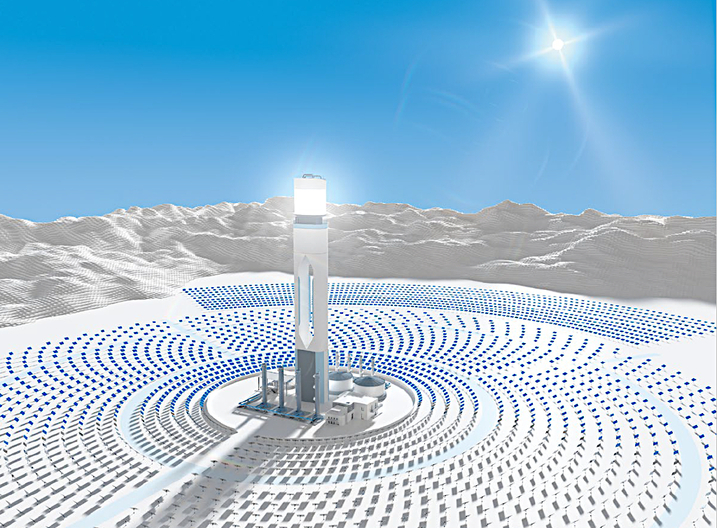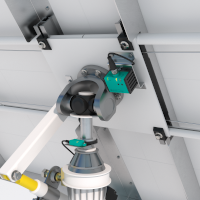Precise Orientation of Heliostats in Solar Tower Power Plants
Rotary Encoders and Inclination Sensors Detect Positions along Two Axes

The Application
In solar tower power plants, light reflected from numerous mirrors is directed at a receiver—a small area in the top of the tower. The resulting heat—up to 800°C—is used to generate steam to power a turbine power plant. Most plants are located in deserts or desert-like areas with a high degree of solar radiation. These areas are characterized by extreme temperature fluctuations between day and night, with both very high and extremely low temperatures being reached. This means that despite the general dryness, condensation can be expected. Sand and dust are generally pervasive, and sandstorms can occur frequently. Large plants are composed of several tens of thousands of heliostats (an apparatus containing a movable or driven mirror, used to reflect the sunlight in a fixed direction).
The Goal
The movable mirrors should always direct sunlight precisely onto the target surface. Their focus points must be distributed as evenly as possible across this surface to prevent specific spots overheating. The alignment of the precisely calibrated mirrors must be constantly maintained during operation. Since the individual mirrors can be positioned up to several hundred meters away from the tower, high-precision measurement of their horizontal and vertical angle is required, i.e., the rotation and inclination of the mirror surface. The technology used for this purpose must be able to withstand the harsh ambient conditions in terms of temperature, humidity, and contamination. The technology also requires a high level of immunity to electrical interference caused by lightning.

The Solution
Horizontal rotation is accurately detected by a MNI40-series magnetic rotary encoder at a high resolution. The rotary encoder can be easily integrated into the drive. Sampling is noncontact and the device does not require any mechanical wear parts. Inclination sensors of the type F99 are used to determine the inclination angle of the vertical orientation. These sensors determine the angle purely electronically, and do not use mechanical components. Both sensors are designed to operate in harsh ambient conditions. They can withstand extreme temperatures, humidity, dirt, and mechanical shock.
Technical Features

Solar Power Tower Sensors
Inclination Sensor INY060D
- Two-axis inclination sensor
- Measuring range: –30° … +30°
- Absolute accuracy: ≤ ±0.2°
- Repeat accuracy: ≤ ±0.04°
- Ambient temperature: –40°C … +85°C
- Resolution: ≤ 0.02°
- Degree of protection IP68/69K
Incremental Rotary Encoder MNI40N:r:
- Freedom from wear, noncontact magnetic detection
- Rugged design (high degree of dust-tightness; withstands humidity, dirt, and mechanical effects)
- Pulse count: max. 7,200
- Operating temperature: –40°C … +100°C
- Degree of protection: DIN EN 60529, IP67, IP68, IP69K
The Benefits
Both sensor series include device versions that have been specially adapted for use in this application. Additional customizations can be made to cater to specific requirements. The modifications already available include changes to the mechanical fastening and the design of the electrical interface, and increased resolution. The inclination sensor is especially easy to install because it does not need to be mechanically connected to a drive.
At a Glance
- High-precision position detection along two axes for accurate heliostat tracking based on the sun´s position
- Highly accurate orientation to the receiver for maximum efficiency
- Rugged devices for use in extreme conditions
- Application- and system-specific customization of sensors








 +49 621 776-0
+49 621 776-0